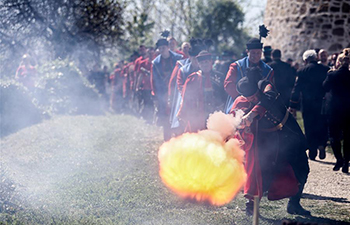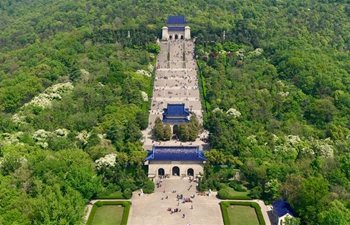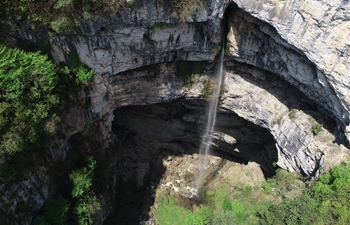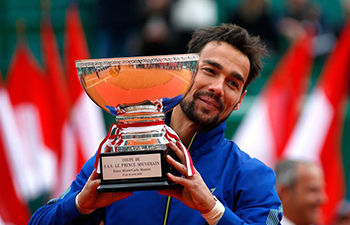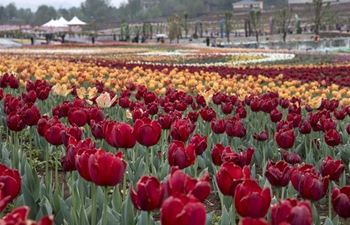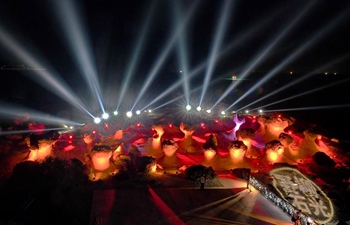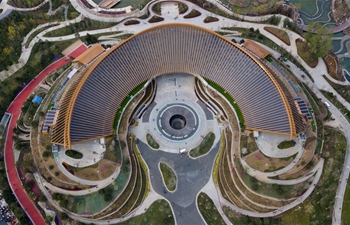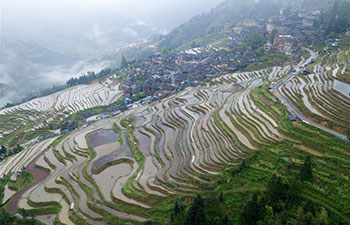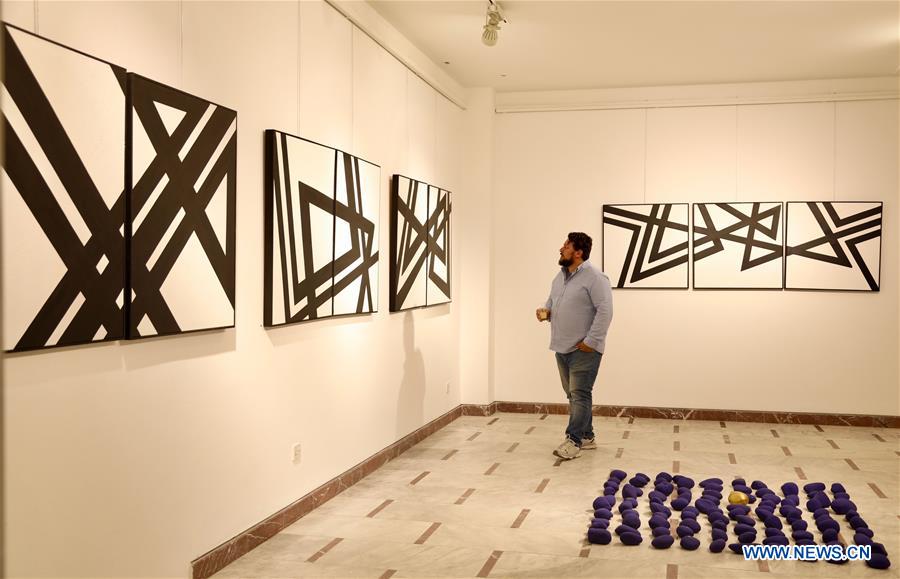
A visitor views paintings at the gallery of an Iraqi artist Zaid al-Ani under the name of "Imagine" at a hall in the French Institute in Baghdad, Iraq, April 20, 2019. Al-Ani presented a collection of paintings of geometric forms drawn in black and white, in which he utilized the human shape in a way that looks like an engrave of a Sumerian cylinder seal. (Xinhua/Khalil Dawood)
by Nabil Salih
BAGHDAD, April 22 (Xinhua) -- Since the U.S.-led invasion of Iraq in 2003, the Iraqi society has been dragged into a whirlwind of violence and extremism that deteriorated most of life aspects, including artistic movement of the country.
However, many people in Baghdad are combatting every day's hardships through art and music, and many new artists are emerging from the ashes of the conflict and are keen to forge a brighter future for their country and themselves.
Under the slogan "It's better to light a candle than curse darkness," Baghdad School for Musical and Expressive Arts held on Thursday its annual festival that included ballet and music performances at the Iraqi National Theater in central Baghdad.
Backstage, the atmosphere was buzzing with energy and anticipation. Young musicians were adjusting their violins, thumping on the strings of their lutes and guitars, while ballerinas applied rosin to their pointe shoes and shrugged off their anxieties prior to performing on stage.
"It is a message to the world that no one can put Baghdad's beauty to death. In our school, we will persevere until the last breath, to present Baghdad in the most beautiful image," Zina Faidhi, director of the ballet department in the school, told Xinhua.
On the stage, the musicians serenaded some 1000 attendants with masterpieces of Bach, Shostakovich and Munir Bashir, with the ballerinas skillfully swaying to the melodies in a sensational and impressive display.
"It is a form of defiance. We are still young and we want to live our lives the way we want and no one will stop us," Tia Ammar, a student and pianist told Xinhua, referring to a wave of criticism and threats to her school last year.
After the annual festival in April 2018, the school received a great deal of degrading criticism and threats from unidentified extremists on social media websites.
But the criticism and threats did not stop Ammar, who insisted to show her pride of what she's doing, "one day they'll love us," she said confidently.
In the aftermath of the U.S.-led invasion and occupation of Iraq in 2003, the country has witnessed a surge of religious extremism that yield the rise of Islamic parties, which crippled the artistic movement in the country and restricted women's rights and freedoms.
"Some people often criticize us and say ballet dancing is haram (or forbidden in Islamic terminology), they hate everything beautiful that we do, but Baghdad is a beautiful city and so we should all be," Faidhi, who selected most of the dances and rehearsed the students, said.
Art and culture were never a priority for post-invasion governments, and in addition to the escalation of extremism that affected its students, the school has been suffering deterioration and funding crisis for sixteen years.
Annie Melconian has been teaching violin at the school voluntarily because most of the contracted teachers had left because they haven't received their salaries for two years.
"Most teachers have quit and many students found themselves with no instructors, I feel sorry for them," said Melconian, who originally is a violinist at the Iraqi National Symphony Orchestra.
Melconian is from the Iraqi Christian minority, and she is also the conductor of the Sharagan Choir of the Armenian Church in Baghdad.
On Saturday, an Iraqi artist Zaid al-Ani held his gallery under the name of "Imagine" at a hall in the French Institute in Baghdad.
Al-Ani presented a collection of paintings of geometric forms drawn in black and white, in which he utilized the human shape in a way that looks like an engrave of a Sumerian cylinder seal.
"In this city (Baghdad), and in the hardest conditions, you find artists expressing themselves and art galleries never stop," al-Ani, 48, told Xinhua.
Despite years of negligence and the absence of support, al-Ani said "the Iraqi individual loves life, perseveres and produces, and I consider this an act of bravery."




